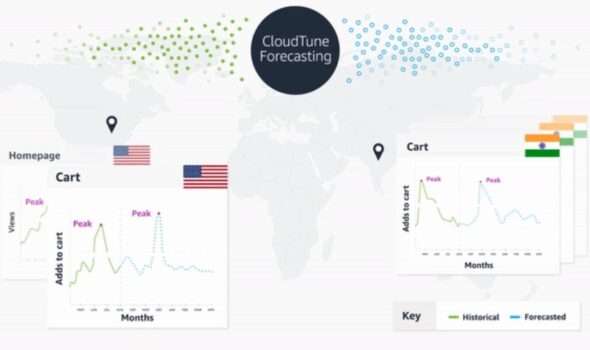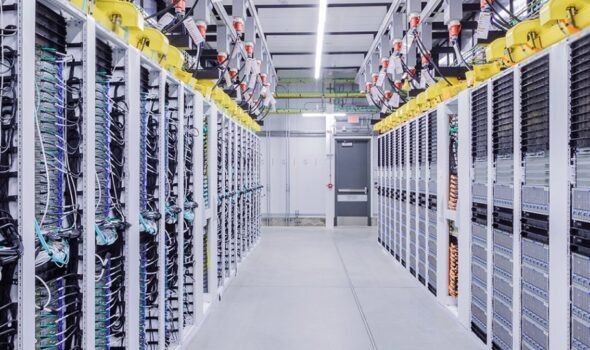Collection of Published Clips
Welcome to John Roach’s clips, a curated collection of links to public-facing, bylined stories for current and past clients. This is a sliver of the thousands of stories he’s written over the course of his career. If you’re looking for something specific or different, please ask.

Amazon Science
October 10, 2023
How CloudTune generates forecasts for the Amazon Store
On what are known as game days to teams inside Amazon, millions of virtual “customers” log on to the Amazon Store to search for items, browse product pages, load shopping carts, and check out as if they were real customers hunting for bargains during a sale such as Prime Day. “It’s like a fire drill, a planned practice,” said Molly McElheny, a principal technical program manager.

Amazon Science
July 18, 2023
Geopipe uses AI to create a digital twin of Earth
Planet Earth is getting a digital twin. A pair of friends who met during high school in an online forum are now using their PhDs in computer science to pioneer artificial intelligence (AI) techniques that will allow them to create an exact digital replica of the world — one that adds deep and rich layers of detail and nuance to the traditional online mapping experience.

Microsoft Source
March 13, 2023
How Microsoft’s bet on Azure unlocked an AI revolution
About five years ago, artificial intelligence research organization OpenAI pitched Microsoft on a bold idea that it could build AI systems that would forever change how people interact with computers. At the time, nobody knew it would mean AI systems that create pictures of whatever people describe in plain language or a chatbot to write rap lyrics, draft emails and plan entire menus.

Microsoft / Innovation Stories
July 28, 2022
Hydrogen fuel cells could provide emissions free backup power at datacenters, Microsoft says
Latham, New York – Hydrogen fuel cells packed into a pair of 40-foot-long shipping containers here ramped up on an overcast day early this June as engineers gathered around laptops displaying data on the state, health and power output of the cells in this first-of-a-kind hydrogen generator. “This is it, it’s running at three megawatts right now,” exclaimed Mark Monroe, a Microsoft engineer.

ADT News
October 27, 2021
Raya Sevilla fast tracks ADT to the future of smart and helpful home security
Raya Sevilla’s hobby of building custom cars out of mismatched parts and then smoking the competition is emblematic of an education and career that recently landed her on the C-suite podium as ADT’s Chief Technology Officer. There, she’s driving a team of engineers that build and fine tune information technology platforms that deliver smart and helpful home security solutions.

Pacific Northwest National Laboratory
June 21, 2021
PNNL AI Expert Harnesses Open-Source Data to Understand Human Behavior
At the outset of the global pandemic in March 2020, Svitlana Volkova and her colleagues turned to the social media platform Twitter to understand and model the spread of COVID-19 misinformation, which was wrinkling hastily hatched plans to protect people from the disease.

Microsoft / Innovation Stories
April 6, 2021
To cool datacenter servers, Microsoft turns to boiling liquid
Quincy, Washington – Ping! Emails and other communications sent between Microsoft employees are literally making liquid boil inside a steel holding tank packed with computer servers at this datacenter on the eastern bank of the Columbia River. Unlike water, the fluid inside the couch-shaped tank is harmless to electronic equipment and engineered to boil at 122 degrees Fahrenheit.

Pacific Northwest National Laboratory
October 26, 2020
The Internet of Things Brings a Web of Promises and Perils to the Smart Grid, Experts Say
The innocuous microwave on a shelf in a laboratory at the U.S. Department of Energy’s Pacific Northwest National Laboratory (PNNL) in Richland, Wash., is anything but ordinary. “Weird,” is how Penny McKenzie, a cybersecurity engineer at the laboratory, describes the device. The microwave arrived at PNNL with the capability to be controlled through a smart speaker connected to the internet.

Microsoft / Innovation Stories
September 14, 2020
Microsoft finds underwater datacenters are reliable, practical and use energy sustainably
Earlier this summer, marine specialists reeled up a shipping-container-size datacenter coated in algae, barnacles and sea anemones from the seafloor off Scotland’s Orkney Islands. The retrieval launched the final phase of a years-long effort that proved the concept of underwater datacenters is feasible, as well as logistically, environmentally and economically practical.

Microsoft / Innovation Stories
January 19, 2020
Using AI, people who are blind are able to find familiar faces in a room
Cambridge, United Kingdom – Theo, a 12-year-old boy who is blind, is seated at a table in a crowded kitchen on a gray and drippy mid-December day. A headband that houses cameras, a depth sensor and speakers rings his sandy-brown hair. He swivels his head left and right until the camera in the front of the headband points at the nose of a person on the far side of a counter.

Microsoft / Innovation Stories
November 7, 2019
The making of the HoloLens2: How advanced AI built Microsoft’s vision for ubiquitous computing
The first time people don the new HoloLens 2 on their heads, the device automatically gets to know them: It measures everything from the precise shape of their hands to the exact distance between their eyes. The artificial intelligence research and development that enabled those capabilities “was astonishingly complicated” but essential to making the experience of using the device “instinctual.”

Microsoft / The AI Blog
October 10, 2019
Smiles beam and walls blush: Architecture meets AI at Microsoft
Redmond, Washington and Ithaca, New York – Jenny Sabin is perched high on a scissor lift, her head poking through an opening of the porous fabric structure that she’s struggling to stretch onto the exoskeleton of her installation piece, which is suspended in the airy atrium of building 99 on Microsoft’s Redmond, Washington, campus. Momentarily defeated, she pauses and looks up.

Microsoft / The AI Blog
April 5, 2018
AI technology helps students who are deaf learn
ROCHESTER, NY — As stragglers settle into their seats for general biology class, real-time captions of the professor’s banter about general and special senses – “Which receptor picks up pain? All of them.” – scroll across the bottom of a PowerPoint presentation displayed on wall-to-wall screens behind her. An interpreter stands a few feet away and interprets the professor’s spoken words.

Microsoft / The AI Blog
June 28, 2017
AI’s big leap to tiny devices opens world of possibilities
Sometimes the best place to showcase the potential of a bold, world-changing technology is a flower garden. Take the case of Ofer Dekel, for example. He manages the Machine Learning and Optimization group at Microsoft’s research lab in Redmond, Washington. Squirrels often devoured flower bulbs in his garden and seeds from his bird feeder, depriving him and his family of blooms and birdsong.

Yale Environment 360
March 3, 2016
Can Data-Driven Agriculture Help Feed a Hungry World?
From Bonneville County, Idaho, to Buenos Aires Province, Argentina, tablet-toting agronomists with Anheuser-Busch InBev — the world’s largest brewer by volume — are visiting farmers who grow the company’s malt barley, a key ingredient in beer. These meetings are a decades-old ritual: Growers review contracts as agronomists offer advice on ways to maximize productivity and profitability.

National Geographic
April 29, 2015
Will Huge Batteries Save Us From Power Blackouts?
Glacier, Washington, is the final stop for coffee and treats on the Mt. Baker Highway, which ends at a ski area holding the world record for most snowfall in a season. The small town in the woods might seem an unlikely spot for a $9.6 million warehouse to store excess energy, but it might prove the perfect testing ground. The area's winter storms routinely knock out power to Glacier.

NBC News
August 4, 2014
Home Solar Panels Make Gains in America, Even in Rainy Seattle
SEATTLE -– Going solar is expensive, but a confluence of plummeting equipment prices, rising utility bills, new financing schemes and a raft of federal, state, and local incentives are encouraging homeowners across America to take the plunge and put photovoltaic panels on their roofs, even in rainy Seattle.

National Geographic News
May 9, 2014
Pacific Northwest’s Salish Sea Eyed as Fossil Fuel Gateway
Trains loaded with crude oil from North Dakota's Bakken shale formation rumble past the outfield bleachers of the Seattle Mariners' baseball stadium several times a week. From there, the trains head north, their cargo destined for multiple refineries in Washington State.

NBC News
August 23, 2014
Who’s Driving That Tanker? New Polar Code For Sailing Emerges
SEATTLE — A quarter-century after a drunk captain and his fatigued crew ran the Exxon Valdez onto a reef where it spilled 10.8 million gallons of crude oil into Alaska's Prince William Sound, new rules are taking shape to prevent a similar disaster in the rapidly opening Arctic Ocean. There, melting sea ice is opening a new frontier.

NBC News
February 17, 2014
Parched California Pours Mega-Millions Into Desalination
Besieged by drought and desperate for new sources of water, California towns are ramping up plans to convert salty ocean water into drinking water to quench their long-term thirst. The plants that carry out the high-tech "desalination" process can cost hundreds of millions of dollars, but there may be few other choices for the parched state.

National Geographic News
January 20, 2012
Unknown “Structures” Not Tugging on the Universe After All?
Mysterious, unseen structures on the outskirts of creation most likely aren't tugging on our universe, according to a new study. The paper reexamines "dark flow"—an unusual, one-way motion of matter—using measurements of supernovae and the existing laws of physics.

National Geographic News
April 27, 2011
Caterpillar Fungus Making Tibetan Herders Rich
Harvesting of a parasitic fungus that grows high on the Tibetan Plateau in China is infusing hordes of cash into rural communities, scientists say. The fungus, Ophiocordyceps sinensis, takes over the bodies of caterpillar larvae then shoots up like finger-size blades of grass out of the dead insects' heads.

MSNBC.com
September 21, 2010
Eight hurdles on the track to a green energy future
The green energy future envisions a technological road that leads to an infinite supply of power, independence from potentially hostile nations and an atmosphere cleared of the excess heat-trapping gases that are blamed for warming the planet. The track to this future, however, is full of technological and policy hurdles. Learn how eight of the biggest hurdles might be cleared.

National Geographic News
March 17, 2010
“Hobbits” Had Million-Year History on Island?
Newfound stone tools suggest the evolutionary history of the "hobbits" on the Indonesian island of Flores stretches back a million years, a new study says—200,000 years longer than previously thought. The hobbit mystery was sparked by the 2004 discovery of bones on Flores that belonged to a three-foot-tall (one-meter-tall), 55-pound (25-kilogram) female with a grapefruit-size brain.

